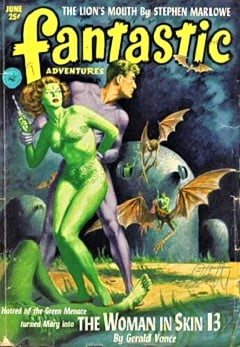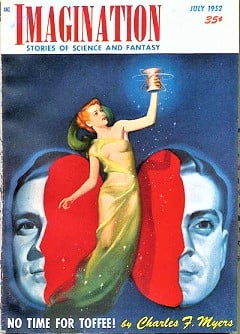
 “The Black Museum. A Repository of Death. Here in the grim stone structure on the Thames which houses Scotland Yard is a warehouse of homicide, where everyday objects . . . all are touched by murder.“
“The Black Museum. A Repository of Death. Here in the grim stone structure on the Thames which houses Scotland Yard is a warehouse of homicide, where everyday objects . . . all are touched by murder.“
The Black Museum (1952) aired (in the United States and as near as historians can reasonably ascertain) “The Mandolin String” on June 17, 1952. The name The Black Museum was coined in 1877 by a reporter for London’s The Observer newspaper, though the museum had opened in 1875 with the official name of simply the Crime Museum. It is the oldest museum in the world to display only artifacts of crime and is still known today by its official name of the Crime Museum despite the more colorful name given it by The Observer. The museum is not open to the public and is used primarily for instructional purposes for police training, but has had special visitors the likes of Sir Arthur Conan Doyle.
The Black Museum was one of four similar shows produced by Harry Alan Towers (1920-2009) under his Towers of London label in the late 1940s and early 1950s. Towers, a native born Britisher, would also produce popular radio fare like Secrets of Scotland Yard, Fabian of the Yard, and WHItehall 1212. All four shows centered around stories from the files of Scotland Yard, and New Scotland Yard’s famous Crime Museum, which was popularized in crime novels as the Black Museum. While all but Fabian of the Yard are verified as being produced and syndicated in Britain for future syndication, it is interesting to note that, according to the Digital Deli Too website entry, “WHItehall 1212 was a National Broadcasting Corporation production written by Lights Out’s famous scriptwriter Wyllis Cooper….” Three of the four shows, The Black Museum among them, would wrap their stories around an artifact from the museum, recounting in dramatic form the infamous crime associated with said artifact. Secrets of Scotland Yard kept to historical facts quite closely, and while a fascinating listen and quite popular, didn’t have the flair or melodramatic effect the likes of Orson Welles (1915-1985) would bring to The Black Museum as the host and narrator of each of its 52 episodes. And while The Black Museum also kept to the historical record surrounding each case, it would play a little fast and loose with them (or perhaps embellish them is the proper word) for dramatic effect, and it didn’t hurt that the show–unlike the others–drew its material solely from murders, thus guaranteeing the audience a chilling half hour. Overlay the grim stories with the somber, virtually hypnotic tones of Orson Welles and you’ve got a winner.

 Speaking of Orson Welles, one might be given to wonder how he came to write some of, and host and narrate all of the episodes of The Black Museum, which were produced in the UK. It seems that Welles decided to take an extended “vacation” in England due to several professional and personal problems, including some “requests” from the Internal Revenue Service. So the American loss turned into Harry Alan Towers’s gain (Towers’s photo at left 1948, at right circa 1984), and he set Welles to work, a profitable solution for both parties. Welles would also work on two other Towers productions, perhaps the most well known to the American radio audience being The Lives of Harry Lime (or The Third Man.) The Third Man was a 1949 film noir British production set in post-World War II Vienna, with Welles playing the Lime character. Written by Graham Greene, it has attained classic status for its stylish portrayal of a decaying and corrupt Vienna, so Towers was striking while the iron was hot and rode the coattails of the film with Welles starring in the radio adaptation.
Speaking of Orson Welles, one might be given to wonder how he came to write some of, and host and narrate all of the episodes of The Black Museum, which were produced in the UK. It seems that Welles decided to take an extended “vacation” in England due to several professional and personal problems, including some “requests” from the Internal Revenue Service. So the American loss turned into Harry Alan Towers’s gain (Towers’s photo at left 1948, at right circa 1984), and he set Welles to work, a profitable solution for both parties. Welles would also work on two other Towers productions, perhaps the most well known to the American radio audience being The Lives of Harry Lime (or The Third Man.) The Third Man was a 1949 film noir British production set in post-World War II Vienna, with Welles playing the Lime character. Written by Graham Greene, it has attained classic status for its stylish portrayal of a decaying and corrupt Vienna, so Towers was striking while the iron was hot and rode the coattails of the film with Welles starring in the radio adaptation.
The airing of The Black Museum episodes presents problems for historians. Produced in 1950, it was first aired as a “pirate broadcast” by Radio Luxembourg, and then throughout Europe. It was eventually licensed by MGM Radio Attractions and ran in the United States under the Mutual Broadcasting System (MBS). MGM hand-picked what it considered to be the best 39 of the original 52 episodes and ran them from January 1, 1952 through December 30, 1952 (with a three month hiatus while a summer replacement filled the gap). There’s more to the odd packaging and eventual airing of select episodes of The Black Museum (Canada’s CBC radio would also purchase some 38-39 episodes and air them at different times than the American run, for but one example), but all of that is neither here nor there for our current purposes.
“The Mandolin String” is, like all the other tales from this radio program, about murder and how the title object figures in, or plays a part in the foul deed. Not wishing to risk revealing too much, all I can offer is that several unfortunate victims find themselves wondering what a long, strange trip it’s been for them.
Play Time: 23:50
{A certain Saturday in June of 1952 found the neighborhood Louisville sluggers at the corner newsstand instead of the nearby park, for the rain had called off their much anticipated baseball game. Plan B was a good one, find some otherworldly adventurous escape via the pages of their favorite pulp magazines. fantastic Adventures (1939-53) never failed to spark the imagination with its action-filled covers including very often a scantily clad female in imminent distress. It was a monthly in 1952. Imagination (1950-58) was the brainchild of Raymond Palmer, who quickly turned around and sold it after two issues to William Hamling and his Greenleaf Publishing Company. Not generally recognized for the quality of its fiction, Hamling nevertheless published stories by Robert Sheckley, Philip K. Dick, Robert A. Heinlein, and John Wyndham. The magazine managed 7 issues in 1952. The venerable Weird Tales (1923-54), the “unique magazine,” was a bi-monthly in 1952, though it would last but a few more years after a long and distinguished run as the first pulp magazine devoted to occult and supernatural fiction.]
[Left: fantastic Adventures, June 1952 – Center: Imagination, July 1952 – Right: Weird Tales, July 1952]



To view the entire list of weekly Old Time Radio episodes at Tangent Online, click here.